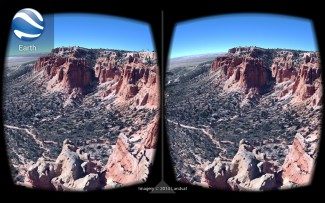Last week Google surprised the crowd at I/O 2014 with the reveal of Cardboard, a low-cost VR smartphone adapter which the company gave away to every developer in attendance. Google, who praise Oculus for “putting VR back into the media’s attention with an awesome device…” recognizes the potential for virtual reality on smartphones and wants to kickstart mobile VR content with Cardboard.
On Thursday, a day after the company revealed the VR smartphone adapter, the Cardboard team held a session at I/O 2014 to introduce the goals of the project to developers. The speakers were Boris Smus, Christian Plagemann, and David Coz, the minds behind the initiative.
Cardboard started as a “20% time” project—Google’s famous perk that allows employees to spend 20% of their time on hobby projects—by David Coz and Damien Henry at the Google Cultural Institute in Paris. The team started by laser-cutting cardboard; they chose the material because of how easy it is to work with. They wanted to build “the simplest and cheapest way of turning your smartphone into a VR viewer,” said Christian Plagemann, and hoped that the low-cost and easy to work materials would inspire developers to prototype and experiment with modifications and additions.
“This is just a placeholder,” Plagemann said at the Cardboard session at I/O 2014, “…this is a piece of cardboard.” Cardboard isn’t tantamount to Google’s entry into the consumer VR space, it’s an effort to significantly lower the barrier to entry for VR developers on Android. Specifically, this is a content play. Google almost certainly knows that device’s like the rumored ‘Gear VR’—a VR smartphone adapter supposedly being jointly developed by Samsung and Oculus—are on the way, and they want Android to be the mobile destination for VR.
“How can we accelerate this even more so that not just tech addicts can experience VR, but anybody with a smartphone?” Coz recalled thinking when the project started; Cardboard was the answer.
A High-tech Piece of Cardboard
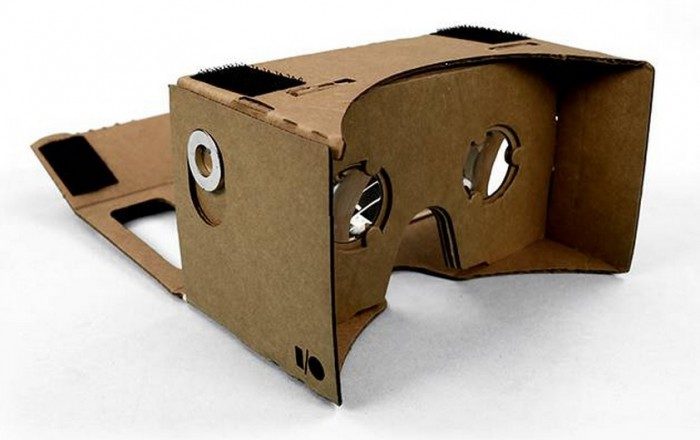 Although the Cardboard VR smartphone adapter is made from a commodity material, the team have made some high-tech modifications to make it usable for virtual reality.
Although the Cardboard VR smartphone adapter is made from a commodity material, the team have made some high-tech modifications to make it usable for virtual reality.
First is the neodymium ring magnet which is used as an input control. They needed a way to interact with the phone without awkwardly touching the screen and obscuring your vision. The team has smartly added a slot for the magnet on the left side of Cardboard, while on the other side is a magnet disk that attracts the ring back to its resting position. When you pull the ring down, the phone’s magnetometer picks up a very distinct reading which is detected as an input event. For now, Cardboard is using the ring magnet for binary input—like an on/off button press—but there’s more than can be done with it, including variable input—for example, varying how fast a web page scrolls by judging how far the magnet is pulled away from the resting position. The Cardboard team says that this concept could be extended further and the magnet could be used as a directional pad, able to read a variety of directions from its origin, but this functionality relies on uncalibrated magnetometers which are not yet used in most phones.
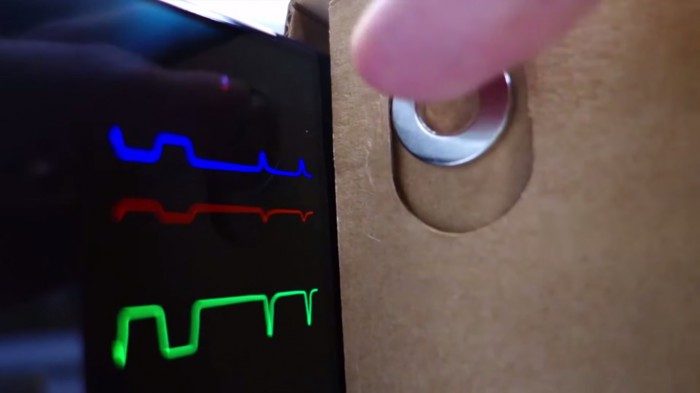
Unfortunately, use of the ring magnet means giving up the use of the compass for absolute heading tracking and drift correction—it interferes too much with the magnetometer. The Cardboard team realized this would be an issue, though they appear to have stuck with the ring magnet implementation for its ease of use, low cost, and universal functionality. They suggest using the phone’s camera for drift-correction, though that function isn’t implemented yet. Google recommends an alternative method which will also work on phones that can’t detect magnet pulls:
You can use Cardboard without the magnet by sticking copper tape along the side of the viewer and having it come into contact with the phone screen. When you tap twice on the copper tape with your finger, the phone will react as if it had detected a magnet pull.
The second feature that makes this piece of cardboard high-tech is the NFC tag positioned on the flap that rests against the back of the phone. This tag is programmed with a code that tells the phone to launch the Cardboard app as soon as it’s inserted into the VR smartphone adapter. The Cardboard team says that this could be used in the future to have the phone switch back and forth automatically from normal to VR-mode for any application. For instance, you could browse to your favorite video on your phone using the YouTube app, then slide the phone into Cardboard and have YouTube automatically launch the video in VR-mode.
The Cardboard team has tested several Android phones which are fully compatible or partially compatible with the Cardboard VR smartphone adapter, though this list isn’t comprehensive.
Fully compatible:
- Google Nexus 4
- Google Nexus 5
- Motorola Moto X
- Samsung Galaxy S4
- Samsung Galaxy S5
- Samsung Galaxy Nexus
Partially compatible:
An App for Inspiration
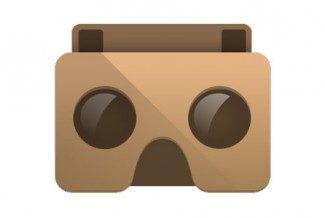 Alongside the Cardboard kit, which the team guesses some 6,000 were given out at Google I/O 2014, a companion app hit the Google Play store on the same day. The app, which requires Android 4.1 or higher, has already been downloaded between 50,000 and 100,000 times, according to the Play Store. Though some of that install base were probably folks without VR smartphone adapters just wanting to see what the hubbub was about, among them are surely those with devices like the Durovis Dive and a bevy of DIY Cardboard units, some of which were completed just hours after Google put the DIY design online.
Alongside the Cardboard kit, which the team guesses some 6,000 were given out at Google I/O 2014, a companion app hit the Google Play store on the same day. The app, which requires Android 4.1 or higher, has already been downloaded between 50,000 and 100,000 times, according to the Play Store. Though some of that install base were probably folks without VR smartphone adapters just wanting to see what the hubbub was about, among them are surely those with devices like the Durovis Dive and a bevy of DIY Cardboard units, some of which were completed just hours after Google put the DIY design online.
The Cardboard app features seven demo experiences for users to try:
- Earth: Fly where your fancy takes you on Google Earth.
- Tour Guide: Visit Versailles with a local guide.
- YouTube: Watch popular YouTube videos on a massive screen.
- Exhibit: Examine cultural artifacts from every angle.
- Photo Sphere: Look around the photo spheres you’ve captured.
- Street Vue: Drive through Paris on a summer day.
- Windy Day: Follow the story (and the hat) in this interactive animated short from Spotlight Stories.
Although the app expects input from the ring magnet on the side of Cardboard, tapping on the touchscreen activates the same input, meaning any VR smartphone adapter can be at least partially compatible with the Cardboard app.
See Also: Google Adds Virtual Reality Street View Mode to Google Maps for Android
It’s interesting to see a VR version of Google Earth pop up in the Cardboard app. Just about one year ago, we saw a version of Google Earth for the Oculus Rift and Leap Motion at Google I/O 2013. The company never released the demo to the public, and it’s possible that this is what came from that initial foray in VR.
In the Google Earth Cardboard demo, you can fly around at low altitude, tilting and turning to steer, or look up to the sky to fly up and see the Earth from space. From there you can select from several interesting locations on the Earth and fly down to explore them.
YouTube
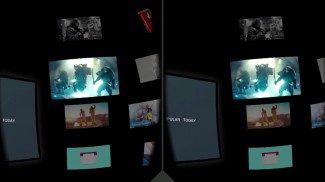 YouTube support this early is also a very positive sign. Currently the YouTube portion of the app plays 2D videos on a virtually huge screen, with floating thumbnails, representing related videos, surrounding the playback screen. Users can look around at thumbnails and use the metal slider to select videos.
YouTube support this early is also a very positive sign. Currently the YouTube portion of the app plays 2D videos on a virtually huge screen, with floating thumbnails, representing related videos, surrounding the playback screen. Users can look around at thumbnails and use the metal slider to select videos.
With YouTube already supporting 3D video playback in a variety of formats, it likely won’t be long until we see 3D support in VR from everyone’s favorite video-sharing site. This also opens the door to what will potentially become a huge market—hosting of spherical virtual reality videos like those being produced by Jaunt and Polygon Window Productions, to name a few. This is a bit more complex because it requires headtracking, rather than mere video playback, but it’s almost certain that there will be a destination for such VR videos.
Exhibit
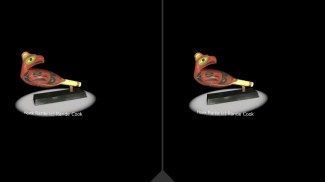 The Exhibit demo is an example of augmented reality input with Cardboard using a phone’s external camera. There is a QR code on the Cardboard kit box which is detected within this demo and then used to manipulate a virtual object that appears on top of it. These sorts of uses are still novel and jumpy, but if the computer vision problems can be solved, there are many useful experiences that could be derived from such AR input.
The Exhibit demo is an example of augmented reality input with Cardboard using a phone’s external camera. There is a QR code on the Cardboard kit box which is detected within this demo and then used to manipulate a virtual object that appears on top of it. These sorts of uses are still novel and jumpy, but if the computer vision problems can be solved, there are many useful experiences that could be derived from such AR input.
Photo Sphere and Windy Day
Photo Sphere and Windy Day on the Cardboard app take existing ‘immersive’ phone experiences, and blows them up for proper VR use. As much as the 2010 era of AR would like us to believe, holding your phone out to peer through a tiny window into another world is not immersive. VR, on the other hand, is the perfect way to make people feel like they are truly in another space.
Photo Spheres are spherical photos which can be taken on any Android phone using the Google Camera app. After shooting a Photo Sphere, you would typically rotate the spherical scene with your finger or by turning the phone in your hand and dictating the view with the phone’s accelerometer. With the Cardboard app, Photo Spheres can be loaded with the proper side-by-side format and see as though the user is standing where the photo was taken from, and navigated intuitively just by looking around.
The Cardboard team says that any Photo Sphere can optionally be opened within the Cardboard Photo Sphere viewer to be seen in virtual reality. In the near future, it may become trivial to capture and share a ‘virtual tour’ of a real estate listing or other space which is best viewed in-person.
Windy Day, an adorable made-for-phone/tablet animated short, does something similar. The animated experience normally allows the user to look around the scene by tilting the phone in their hands. In the Cardboard app, you get an immersive experience as though you are right there with the characters, and you view the scene simply by moving your head around.
In addition to these demos, developers are encouraged to take advantage of Google’s ‘experimental’ VR Toolkit SDK. Google defines ‘experimental as follows:
It means we won’t support the VR Toolkit at the same level or quality that we support core Android SDKs and libraries. And things may change or break as we continue working on it. We are sharing it at this early stage to give developers the chance to experiment with it as we do.

